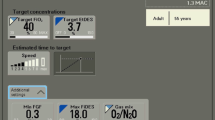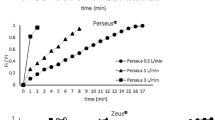Abstract
During low-flow manually-controlled anaesthesia (MCA) the anaesthetist needs constantly adjust end-tidal oxygen (EtO2) and anaesthetic concentrations (EtAA) to assure an adequate and safe anaesthesia. Recently introduced anaesthetic machines can automatically maintain those variables at target values, avoiding the burden on the anaesthetist. End-tidal-controlled anaesthesia (EtCA) and MCA provided by the same anaesthetic machine under the same fresh gas flow were compared. Eighty patients were prospectively observed: in MCA group (n = 40) target end-tidal sevoflurane (1 %) and EtO2 concentrations (≥35 %) were manually controlled by the anaesthetist. In EtCA group (n = 40) the same anaesthetic machine with an additional end-tidal control feature was used to reach the same targets, rendering automatic the achievement and maintenance of those targets. Anaesthetic machine characteristics, amount of consumed gases, oxygen and sevoflurane efficiencies, and the amount of interventions by the anaesthetist were recorded. In EtCA group EtAA was achieved later (145 s) than in MCA (71 s) and remained controlled thereafter. Even though the target expired gas fractions were achieved faster in MCA, manual adjustments were required throughout anaesthesia for both oxygen and sevoflurane. In MCA patients the number of manual adjustments to stabilize EtAA and EtO2 were 137 and 107, respectively; no adjustment was required in EtCA. Low-flow anaesthesia delivered with an anaesthetic machine able to automatically control EtAA and EtO2 provided the same clinical stability and avoided the continuous manual adjustment of delivered sevoflurane and oxygen concentrations. Hence, the anaesthetist could dedicate more time to the patient and operating room activities.

Similar content being viewed by others
References
Baxter AD. Low and minimal flow inhalational anaesthesia. Can J Anaesth. 1997;44:643–53.
Conway CM. Closed and low flow systems. Theoretical considerations. Acta Anaesth Belg. 1984;34:257–63.
Baum JA. Low-flow anesthesia: theory, practice, technical preconditions, advantages, and foreign gas accumulation. J Anesth. 1999;13:166–74.
Odin I, Feiss P. Low flow and economics of inhalational anaesthesia. Best Pract Res Clin Anaesthesiol. 2005;19:399–413.
Kennedy RR, French RA. Changing patterns in anesthetic fresh gas flow rates over 5 years in a teaching hospital. Anesth Analg. 2008;106:1487–90.
Nunn G. Low flow anaesthesia. Cont Educ Anaest Crit Care Pain. 2008;8:1–4.
Struys MM, Kalmar AF, De Baerdemaeker LE, Mortier EP, Rolly G, Manigel J, Buschke W. Time course of inhaled anaesthetic drug delivery using a new multifunctional closed-circuit anaesthesia anesthetic machine. In vitro comparison with a classical anaesthesia machine. Br J Anaesth. 2005;94:306–17.
Sieber TJ, Frei CW, Derighetti M, Feigenwinter P, Leibundgut D, Zbinden AM. Model-based automatic feedback control versus human control of end-tidal isoflurane concentration using low-flow anaesthesia. Br J Anaesth. 2000;85:818–25.
De Cooman S, De Mey N, Dewulf BBC, Carette R, Deloof T, De Sosnowski M, Wolf AM, Hendrickx JF. Desflurane comsuption during automated closed-circuit delivery is higher than when a conventional anesthesia machine is used with a simple vaporizer-O2-N2O fresh gas flow sequence. BMC Anesthesiol. 2008;8:4.
Lortat-Jacob B, Billard V, Buschke W, Servin F. Assessing the clinical or pharmaco-economical benefit of targEt controlled desflurane delivery in surgical patients using the Zeus anaesthesia machine. Anaesthesia. 2009;64:1229–35.
Singaravelu S, Barclay P. Automated control of end-tidal inhalation anaesthetic concentration using the GE Aisys Carestation™. Br J Anaesth. 2013;110:561–6.
Tay S, Weinberg L, Peyton P, Story D, Briedis J. Financial and environmental costs of manual versus automated control of end-tidal gas concentrations. Anaesth Intensive Care. 2013;41:95–101.
Quénet E, Weil G, Billard V. Optimisation de l’administration des agents anesthésiques inhalés: débit de gaz frais ou fraction délivrée? Ann Fr Anesth Reanim. 2008;27:900–8.
Heinonen EP, Haggblom TJ, Halinen H. Inhalation anaesthesia delivery system and method. United States Patent Application Publication No. US 2009/0050148 A1.
Dinneen LC, Blakeesley BC. Generator for the sampling distribution of the Mann Whitney U statistic. Appl Stat. 1973;22:269–73.
Katoh T, Bito H, Sato S. Influence of age on hypnotic requirement, bispectral index, and 95% spectral edge frequency associated with sedation induced by sevoflurane. Anesthesiology. 2000;92:55–61.
Katoh T, Nakajima Y, Moriwaki G, Kobayashi S, Suzuki A, Iwamoto T, Bito H, Ikeda K. Sevoflurane requirements for tracheal intubation with and without fentanyl. Br J Anaesth. 1999;82:561–5.
Katoh T, Ikeda K. The effects of fentanyl on sevoflurane requirements for loss of consciousness and skin incision. Anesthesiology. 1998;88:18–24.
Eger EI 2nd, Shafer SL. Tutorial: context-sensitive decrement times for inhaled anesthetics. Anesth Analg. 2005;101:688–96.
Bailey JM. Context-sensitive half-times and other decrement times of inhaled anesthetics. Anesth Analg. 1997;85:681–6.
Author information
Authors and Affiliations
Corresponding author
Rights and permissions
About this article
Cite this article
Lucangelo, U., Garufi, G., Marras, E. et al. End-tidal versus manually-controlled low-flow anaesthesia. J Clin Monit Comput 28, 117–121 (2014). https://doi.org/10.1007/s10877-013-9516-8
Received:
Accepted:
Published:
Issue Date:
DOI: https://doi.org/10.1007/s10877-013-9516-8




